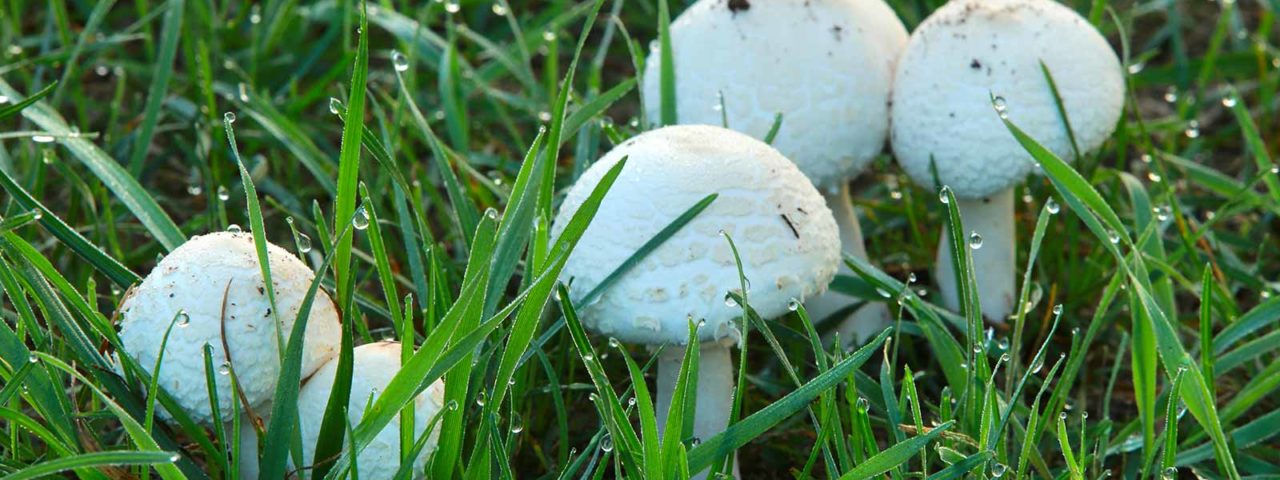Do I Need Treatment Services for Mushrooms in Lawn?
What Are Mushrooms?
Comparable to the fruit of trees, mushrooms are the reproductive structures, or “fruit”, of fungi. Instead of seeds, mushrooms have spores that grow between gills or inside the spongy portion under the mushroom’s cap. When the spores drop to the ground, they germinate and form new threads of fungi root networks (mycelium) in the soil or along another host.
Mushrooms can damage the grass patches they’re growing in and tend to look unsightly in a pristine yard. While you may only be seeing mushrooms here or there, the mycelium networks living under the soil can be vast and continue to cause mushroom problems unless taken care of.
Mushrooms range in size from fractions of an inch to many inches across.
Common Lawn Mushroom Types
While many are benign, some mushrooms are toxic and even poisonous to humans and pets. Children, cats, and dogs should avoid picking or eating the mushrooms growing in your yard. The types of mushrooms we’ve commonly found in yards include:
- Brown Cone Head
- Death Cap *Poisonous
- Destroying Angel *Poisonous
- Fairy Bonnet
- False Parasol
- Honey Fungus
- Horse Mushrooms
- Meadow Mushroom
- Puff Ball
- Shaggy Ink Cap
- Spring Agrocybe
- Stinkhorn Fungus
Why Are Mushrooms Growing in My Yard?
Mushrooms enjoy rich, moist soils with the presence of decomposing organic matter like bark, leaves, logs, stumps, mulch, and shrubs. If you’ve noticed mushrooms in your lawn, there’s a good chance your yard gets plenty of water and has lots of shade.
You may also have compacted soil, and issues with proper drainage. More likely than not, you have an extended network of mycelium in your soil that’s healthy enough to produce fruiting bodies of mushrooms year after year.
Damage Caused By Mushrooms
Mushrooms don’t typically cause large problems on their own, but can be indicators of other fungus issues and diseases you’d rather keep away from your vegetation. Fungi can have dramatic impacts on your grass, garden, flowers, shrubs, and even trees. Common problems caused by mushrooms and fungus disease include:
- Anthracnose
- Black Spot
- Blight
- Club Root
- Downy Mildew
- Grass wilting/death
- Leaf wilt
- Mushroom root rot (Armillaria root rot)
- Plant Virus
- Powdery Mildew
How Can I Prevent Mushrooms in Lawn?
Avoid Overwatering
Mushrooms in lawns are often a sign of overwatering, which means water is also being wasted. Recalculating the watering needs of your grass will help to ensure your lawn stays green while clusters of mushrooms remain unable to grow. Check your drip systems and sprinkler heads for signs of trouble.
Make Room for Sun
You may want to consider trimming away branches and undergrowth that prevent the sun from penetrating to the soil or keep the area damp. Removing these excess structures will open your yard up for healthier grass growth while still protecting you from the sun’s heat.
Dethatch, Aerate, and Remove Clippings
Dense, thick soils and grass with a significant thatch layer make perfect homes for mushroom structures to grow. Make sure you’re raking your lawn often and removing the dead layer underneath. Lawn aeration will help to prevent soil from condensing and opens up the earth for more oxygenation and sunlight. When you mow, make sure to remove grass clippings to eliminate a possible food source and the accumulation of debris.
Use a Slow Release, Nitrogen Rich Fertilizer
Mushrooms in lawns can deplete your soil of important nutrients. Adding a regular, slow release fertilizer to your lawn care routine will help to ensure your lawn has all the vital nutrients it needs to root deeper and continue to thrive, should mushrooms appear.
How to Get Rid of Mushrooms in Your Lawn and Garden
If you’ve noticed mushrooms in lawns in your neighborhood, it’s only a matter of time before they read yours. If you already noticed mushrooms in your lawn, it may be a good idea to call Senske’s Lawn Care Professionals. We’ll identify the types of mushrooms you’ve found, pinpoint important lawn maintenance issues to address, and eliminate the fungus mushrooms and their networks to prevent more growth.
If your lawn or garden has mushrooms popping up, contact a Senske Lawn Care professional at (877) 944-4007 or click to request an estimate online for FREE.

